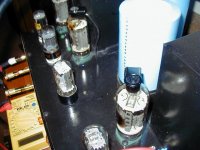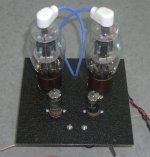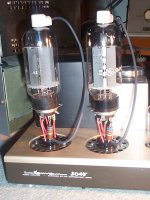Just curious what people have done to attach the top cap lead under the top of an amplifier chassis. Do you use a simple hole with rubber grommet, or some type of connector, or what? Of course, this is just a tiny excuse to show of your amp!
sorry, no pix - but for some EL38s I used British made 6mm black plastic plates with phospor contacts. For running the lead, I was lucky enough that the Dynacos already have nearby slots in the metal work. Suggest some heatshrink tubing / rubber / grommet / strain relief to stop the wire from rubbing and potentially shorting out.
will take some pics soon
For future use I would like to build some top-plate cap adapters with the top-cap running to an octal adapter.
will take some pics soon
For future use I would like to build some top-plate cap adapters with the top-cap running to an octal adapter.
Tubes with caps in my amplifier are mounted into case, and are layed on the side, none of them are sticking out.
http://audio.ring.lt/pw36/36_e.html
It is more safe, there is no high voltages above the chassis
http://audio.ring.lt/pw36/36_e.html
It is more safe, there is no high voltages above the chassis
Hole + grommet is fine. Grommet may not be necessary if your wire is tough enough. If you're using a perforated sheet a la Morgan Jones just take your pick of holes. Re tubes inside the chassis: isn't half the fun in seeing the glow..?
kstagger said:For future use I would like to build some top-plate cap adapters with the top-cap running to an octal adapter. [/B]
okay, any pics of these as well would be nice 🙂
Look here:
http://www.vacuumtubes.com/6BG6.html
These tubes rock by the way. I made my own adapters by using the base of dead Chinese KT88's. Too ugly to post pictures.
http://www.vacuumtubes.com/6BG6.html
These tubes rock by the way. I made my own adapters by using the base of dead Chinese KT88's. Too ugly to post pictures.
This amp is mine. I didn't build it, but I brought to the operating state 🙂
No grommet or anything, just a drilled hole; however, the wire has a tough braided cloth like material outside. The top plate is very thick, not much of a chance to cut through the wire.
No grommet or anything, just a drilled hole; however, the wire has a tough braided cloth like material outside. The top plate is very thick, not much of a chance to cut through the wire.
Attachments
Here is the top half of my amp, showing the rubber grommet for the plate leads. I use a silicone insulated wire that is very limp and flexible, stocked in various colors by people who cater to model car enthusiasts. It's durable and stands up well to high temperatures. It also is a nice, snug fit into the tube cap
Attachments
Silicon wire, eh? I'm on it!
pchw, where did you get those plate caps? I'm always on the lookout for caps that actually fit. I hate the way many of the ceramic ones "fit" ie, do make a secure electrical connection, but look like they're floating above the tube.
Think I'll start a new thread on this...
pchw, where did you get those plate caps? I'm always on the lookout for caps that actually fit. I hate the way many of the ceramic ones "fit" ie, do make a secure electrical connection, but look like they're floating above the tube.
Think I'll start a new thread on this...
For future use I would like to build some top-plate cap adapters with the top-cap running to an octal adapter. [/B]
I did it like this for a 6LW6 test run:
Attachments
Let me know when you find some... Mine are the usual Chinese BS, and they are a bit loosey-goosey on the 1625 tubes shown in the picture. I have some old Millen plate caps floating around somewhere. If I can take the time to find them, I'll see if they fit any tighter. The old style tube caps are pretty scarce and expensive. I can't even find the old bakelite caps any more. If I had a time machine, I'd go back and buy a couple of bushel baskets full, maybe buy some selected stocks while I was at it....
Hi CarlyBoy,
I didn't build this amp. It is a commercial amp by McAlister Audio (http://www.mcalisteraudio.com) from Canada. My friend sold it to me. The owner, Peter McAlister, is a very nice guy. Contact him to see he can point you to his source. Yes, those caps are very nice.
I didn't build this amp. It is a commercial amp by McAlister Audio (http://www.mcalisteraudio.com) from Canada. My friend sold it to me. The owner, Peter McAlister, is a very nice guy. Contact him to see he can point you to his source. Yes, those caps are very nice.
I've got one project in the Photo Gallery. This one uses 6BQ6GTBs, and This Project uses 807s. In both cases, grommeted hole through the chassis. NBD.
Hi,
My next build will be a 807 amp. I have the Chinese top caps, but want to put anode stoppers in the caps. Anyone got any ideas how I might implement this without it looking vomit😕
Shoog
My next build will be a 807 amp. I have the Chinese top caps, but want to put anode stoppers in the caps. Anyone got any ideas how I might implement this without it looking vomit😕
Shoog
I don't think I'll post a picture of my 813 amplifier in one of its development phases; like most of my stuff it looked a bit of a lash-up.
I used rubber grommets, and as the output valves were running at around 1kV, I used PTFE insulated cable with an additional sleeve. For the umbilicals connecting the HT from the separate power supply, I used PET connectors and TV EHT cable which is cheap and rated at 25kV.
7N7
I used rubber grommets, and as the output valves were running at around 1kV, I used PTFE insulated cable with an additional sleeve. For the umbilicals connecting the HT from the separate power supply, I used PET connectors and TV EHT cable which is cheap and rated at 25kV.
7N7
I like using silicone test lead wire - it's flexible but its outer diameter is big enough to be managable and look good. I used larger diameter stuff on the 813 amp. For the grid leads on the 829B amp, I used some teflon coax, since it tended to pick up hum (it's the amp input). You gotta watch the capacitance, though - it's high, so only a few inches can be used.
For passing the lead through the chassis, I like these:
An externally hosted image should be here but it was not working when we last tested it.
http://www.heyco.com/pages/products/section_1/1-11.html
Nice thing about them is that they secure the wire so that even if you tug on it from outside, no worries about the solder joints inside.
I've also used various other rubber grommet things, usually with a tie wrap positioned underneath to keep the wire from getting pulled out.
Pete
Miles Prower said:I've got one project in the Photo Gallery. This one uses 6BQ6GTBs, and This Project uses 807s. In both cases, grommeted hole through the chassis. NBD.
hello Miles, i saw your photo of the 807 amp, what's connected to the two heatsinks?
bill
- Status
- Not open for further replies.
- Home
- Amplifiers
- Tubes / Valves
- Top cap tube users: pics of your amps?



